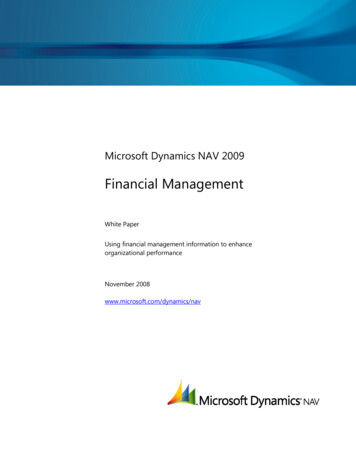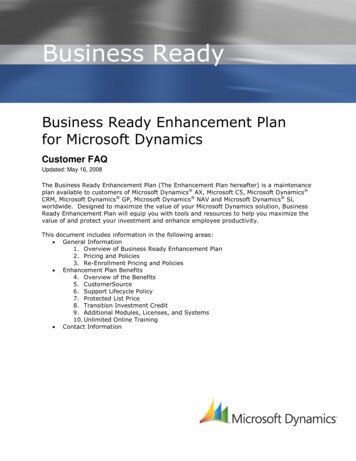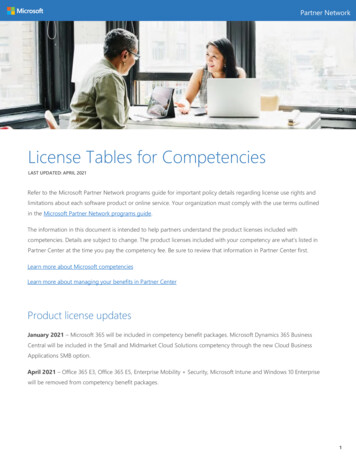
Transcription
Microsoft Dynamics NAV 2009Financial ManagementWhite PaperUsing financial management information to enhanceorganizational performanceNovember 2008www.microsoft.com/dynamics/nav
ContentsIntroduction . 3Executive Summary . 3Challenges of Financial Management . 3The Need for an Integrated Solution . 4Audit Trails and Legal Requirements . 5How Financial Information Is Used Throughout the Organization . 5Providing a “Single Truth” . 5Supporting Better Decision-Making . 6Reporting . 6Facilitating Regulatory Compliance . 6Importance of Reporting and Business Analytics . 7A Challenge for Small Organizations. 7Using Online Analytical Processing to Speed Queries . 7Using Microsoft Dynamics NAV to Maximize Financial Management. 8Financial Management . 8Multiple Business Entities . 10Multi-Site and International Organization Deployments . 10Compliance Initiatives . 10Integration with SQL Server 2005 . 12Business Analytics. 12Integration with Additional Analytical Tools . 13Conclusion . 14Appendix: New Features and Functions Overview . 15Financial Management Enhancements . 15Additional Enhancements . 152MICROSOFT DYNAMICS NAV 2009: FINANCIAL MANAGEMENT
IntroductionThis white paper is intended for Microsoft Dynamics NAV customers. It reviews how Microsoft DynamicsNAV 2009 financial management tools and the integrated capabilities in Microsoft Dynamics NAV 2009help organizations maximize the value of their financial data to empower finance staff, executives, analysts,and other decision-makers.After reading this paper you will understand: The need for an integrated solution when deploying financial management applications. The value of expandability beyond core financial management functionality. How financial information is used throughout the organization. How to use Microsoft Dynamics NAV to overcome the challenges of financial management. The importance of reporting and analytics.Executive SummaryIn an ever more competitive business world, small and midsized organizations need financial managementsolutions that can be expanded beyond core functionality and integrated with other applications and datastores. This not only gives executives and other users an optimal platform for operating their business, butalso provides deep insight into the business to help guide operations and strategic initiatives through richreports and analytics.Microsoft Dynamics NAV is an integrated business management solution that provides financialmanagement, customer relationship management (CRM), and supply chain management (SCM)functionality. It has a modular design so people can easily use the functionality required to meet theevolving needs of their business. This integrated design means that business processes and information areshared across applications. Data is gathered in a central database (Microsoft SQL Server 2005 or thenative database) that can be reported against, and used by analytical tools to generate businessintelligence.Microsoft Dynamics NAV provides a complete financial management solution, making it easy to connectfinancial transactions and information smoothly across affiliate companies and multi-site and internationaldeployments while providing the audit trails and other security measures required by mandates such asSarbanes-Oxley, Basel II, the U.S. Health Insurance Portability and Accountability Act (HIPAA), InternationalFinancial Reporting Standards (IFRS) and local Generally Accepted Accounting Principles (GAAPs). Asorganizations grow, as the marketplace becomes more competitive, and as regulations become morecomplex, the modular design of Microsoft Dynamics NAV enables you to extend functionality by adding inthe solutions you need to manage financial data and generate the analytics and business intelligence thatcan help your company grow into the future.Challenges of Financial ManagementThe challenges and complexity of financial management continue to grow, paralleling the increasingcompetition of the global marketplace. To survive and thrive in today’s economic pressures organizationsneed every advantage they can find, including solutions that can enhance their financial management.3MICROSOFT DYNAMICS NAV 2009: FINANCIAL MANAGEMENT
Organizations want financial management solutions that are robust yet easy to use. They require solutionsthat are flexible to accommodate customization, and expandable to meet future business needs andaccommodate growth.A financial management solution has to go beyond the basics of planning, budgeting, bookkeeping, andmanaging cash flow so organizations can extract added value from financial data to help decision-makersbetter guide the business. Organizations need the ability to explore their own data to extract insights forstrategic planning and to provide reliable financial forecasts.The Need for an Integrated SolutionOrganizations typically generate a lot of disparate information, but often do not have a clear view into thebusiness. Integrating functionality and data sources that traditionally have been stored in separateapplications and databases is essential for organizations that want clear insight into data from across thebusiness.Financial management solutions need to integrate processes and data to help break down the artificialbarriers of information silos, and information entered into one application must be simultaneouslyavailable for use in other applications. Integration can also better connect everyone in the organizationwith customers, suppliers, and trading partners—including across the Internet and from intranetcollaboration portals.Integrating data across applications can boost productivity by freeing users from the burden of having topull information from separate sources, and enhances financial management by unlocking data for what israpidly becoming one of the most important areas of financial management—business intelligence.Business intelligence, in concert with other reporting and analytic solutions, helps inform and speed updecision-making. It enables an organization to respond more quickly to new competitive challenges andproactively take advantage of new market opportunities.Ideally, a financial management solution also should integrate with popular productivity applications suchas Microsoft Office Excel , Microsoft Office Word, Microsoft Office Outlook for customer relationshipmanagement, and Microsoft Office SharePoint Server 2007 for collaboration portals.ExpandabilityThe same application used for general financial management, such as general ledger, accounts payable,accounts receivable, inventory, and other traditional functions, should be expandable into other businessprocesses. The value of financial management applications is magnified when CRM, SCM, and otherbusiness and strategic information management systems functionality can be integrated and shared.This kind of expandability helps ensure a smooth user experience, and removes the barriers that mightotherwise exist to sharing data and functionality across applications. Employees gain the ability to quicklyand easily click their way to details about everything from production schedules and inventory levels tosales orders and marketing campaigns—all by accessing a single, security-enhanced database so peoplecan make decisions based on the same store of data.CustomizationA financial management solution should provide a wealth of existing reports and forms, and also enableusers to easily add or remove fields from existing forms or reports and create others as required to match4MICROSOFT DYNAMICS NAV 2009: FINANCIAL MANAGEMENT
how your organization does business. This enables users to create personalized solutions that can boostproductivity, ease of use, and overall satisfaction.Audit Trails and Legal RequirementsToday’s financial management solutions must provide easily accessible audit trails and support other formsof verification or security as mandated by Sarbanes-Oxley, Basel II, HIPAA and other regulatory andcompliance organizations. The solution needs to support corporate quality initiatives and integrate withaudit and compliance functionality.Support for Reporting and AnalyticsOrganizations also need financial management solutions that support, or better yet, directly integrate withrobust reporting and analytical solutions. Without a flexible and easy-to-use reporting and analysis systemin place, executives and analysts cannot get the insight they need to make informed decisions aboutbusiness expansion, product marketing, pricing, and a host of other success factors.IntegrationOrganizations need an integrated, adaptable software solution that can quickly and easily provide multipleiterations of forecasts and budgets, enable user-defined forecast rules, and support what-if scenarios.Business intelligence scenarios, which are often built upon data warehouses and multidimensional analyticcubes, require that an organization be able to easily integrate its financial management solutions—including SCM and CRM—with relational databases and analytic and reporting tools.Ease of UseEase of use is important to all organizations, but especially for small businesses that often have no ITdepartment. Financial data must be accessible in a format that is easy to view and analyze as well as exportand publish to security-enhanced tools and solutions such as Excel and SharePoint Server.How Financial Information Is Used Throughout the OrganizationFinancial management information forms the foundation of business success. Organizations achieve betterperformance and planning when financial management data is measured precisely and then madeavailable to decision-makers within and beyond the finance department.In addition to enabling the essential bookkeeping functions, effectively managed financial managementinformation enables organizations to plan, forecast, and track performance toward objectives. Financialmanagement data can help keep individuals and teams focused on tasks that add high value, whileproviding the information needed to enhance collaboration.Ideally, financial information is used throughout an organization. Executives need relevant financialinformation to guide decisions about profitability and strategic initiatives. Managers analyze and shareinformation to help ensure that business processes are running smoothly, and employees shareinformation about specific projects.Providing a “Single Truth”A financial management solution that is tightly integrated with all relevant data sources within anorganization makes a significant contribution to forecasting precision and worker productivity by creating5MICROSOFT DYNAMICS NAV 2009: FINANCIAL MANAGEMENT
a “single truth”—a core data set upon which all reporting and analytics can be based. In the absence of anaccepted core data set and a corresponding set of definitions that guide report creation, differentdepartments can create incongruent figures supposedly describing the same financial profile. Without asingle version of their data, organizations can spend too much time trying to reconcile conflicting datainstead of forming the strategies that the data should be guiding.Supporting Better Decision-MakingWith access to financial information, organizations can make better, more informed business decisions. Fora variety of people—top executives, product development leaders, analysts, and warehouse and plantmanagers—success can hinge on having ready access to the most current and complete financial datapossible.Integrating data from across the organization can yield rich insights that might otherwise remain obscured.Financial information gains even more value when it can be exported to a spreadsheet for further analysis,or searched and categorized by integrated reporting applications.As companies look toward longer-term planning, they’ll need data from the financial managementsolution to provide business insights and help guide strategy. Information from a unified data store can bequeried and analyzed to help an organization identify opportunities for expansion and to identify andcapitalize on market opportunities.ReportingOrganizations also draw value from their financial information, in part, by using it to generate reports. Thebetter the reporting application and the larger the data store, the greater the value decision-makers canpull from the data. Reporting underscores the need to break down application and data silos and todeploy an integrated financial management solution that unifies information storage within a centralrelational database.A reporting solution should provide the basic recurring reports such as inventory levels, monthly salesactivity, and profit and loss statements, as well as support the ability to customize existing reports andcreate entirely new ones to better share relevant data across teams, product groups, and other entities.Creation of new reports should be supported with customizable templates or with report-making wizards.Financial information should be easily exportable to productivity tools such as Excel and Word to simplifythe use of data in spreadsheets, documents, and presentations. Organizations need to be able to share theinformation on the Web or from their intranet, giving security-enhanced access to the right informationfrom any location.Facilitating Regulatory ComplianceCompliance can present challenges because of its cost and complexity. Even when your own organizationisn’t directly affected by mandated regulations, you may be required to document compliance when doingbusiness with companies or in markets that are subject to regulation. Organizations need to be able todepend upon their financial management solution to facilitate adherence to and documentation ofregulatory compliance.6MICROSOFT DYNAMICS NAV 2009: FINANCIAL MANAGEMENT
Importance of Reporting and Business AnalyticsThe quest for business intelligence underscores the importance of deploying a financial managementsolution that integrates with other systems currently in use by the organization, or planned for futuredeployment. Bringing all of this data together into a central repository makes it available for reportingagainst and launching analytical queries.According to one industry analyst, business intelligence has surpassed security as the top technologypriority in 2006. Organizations are turning to business intelligence to resolve common challenges,including: Increasing volume of data and too many islands of information, including data stored on personalcomputers. Lack of a single, simple solution for reporting and operational analysis. The need for better controls for budgeting and financials. Fear of adopting new technologies that might conflict with existing systems. The need to identify performance shifts in sales of products or services. The need for a “single version of the truth” for creating reports and financial models based uponthe same core data.A Challenge for Small OrganizationsGenerating business intelligence can be a challenge for small to midsized organizations that typically havefew dedicated IT professionals, and even fewer who are fluent in the technology of generating reportingand analytic solutions. Similarly, small to midsized organizations traditionally lack the infrastructure tosupport a data warehouse and the extraction, transformation, and load processes used to importheterogeneous data into a homogenous relational database.Fortunately the infrastructure costs of supporting business intelligence have fallen in recent years, thoughit is still essential for an organization to carefully choose a financial management system that integrateswell with other solutions, including a relational database and the reporting and analytical tools required forgenerating business intelligence.Using Online Analytical Processing to Speed QueriesAs organizations collect increasing volumes of data, a data warehouse is often used as the basis for abusiness intelligence decision-support system. A data warehouse provides an environment in which datacan be queried and reported against without having an impact on the daily business loads of the onlinetransaction processing (OLTP) data stores.A data warehouse is frequently augmented by an online analytical processing (OLAP) tool that organizesdata to facilitate analytical queries rather than transaction processing. Frequently queried data is preaggregated and the results are stored as multidimensional cubes, which are table-like structures thatenable very fast response time to ad hoc queries. An OLAP solution should be designed for usability tomake it easy for an organization to design, deploy, and maintain cubes, including adding and subtractingdimensions.7MICROSOFT DYNAMICS NAV 2009: FINANCIAL MANAGEMENT
Dimensions map data warehouse table information into a hierarchy of levels, such as a Geographydimension with dimension levels of Continent, Country, State/Province, and City. Dimensions should beindependently created and shared among cubes for ease of cube construction and to help ensureconsistency of analysis data summarization.Using Microsoft Dynamics NAV to Maximize Financial ManagementMicrosoft Dynamics NAV delivers integrated functionality to support solutions for an array oforganizational needs, including: Financial management Customer relationship management Supply chain management System management Manufacturing Distribution E-BusinessMicrosoft Dynamics NAV brings together an array of functionality and features so users can capture,organize, share, and leverage critical business information across the company, as well as with key partners.The fully integrated business solution is easy to customize and simple to use and maintain. Asorganizations grow or diversify they can simply add additional Microsoft Dynamics NAV functionality totheir deployment.Built on Microsoft technology, Microsoft Dynamics NAV integrates with a number of Microsoft programsand technologies to help companies realize business success by enabling employees to work moreproductively in a cost-efficient way; connecting people, processes, and information throughout thebusiness; and providing employees with better insight so they can make informed decisions.Financial ManagementMicrosoft Dynamics NAV offers a full general ledger solution that provides the basic facilities necessary forsetting up a company and posting to the general ledger: chart of accounts, general journals, value-addedtax (VAT) facilities, recurring journals, and source codes. Microsoft Dynamics NAV makes it easy toaccomplish a spectrum of financial management tasks, such as: Setting up accounts in the chart of accounts. For each account established, there is a balance/budget window that shows budget figures and/or actual figures for the entire chart of accounts, orfor individual accounts. Viewing continually updated balances and net changes. Checking how journal entries will affect the liquid accounts before they are posted. Easily trackposted general ledger entries and reverse entries that were posted with incorrect information. Entering figures in the general journal in any currency. Defining the fiscal year as beginning on any date and dividing it into accounting periods.8MICROSOFT DYNAMICS NAV 2009: FINANCIAL MANAGEMENT
Creating budgets in a matrix window, for a day, week, month, quarter, year, or any accountingperiod. Developing budgets based on department, project, or business unit.An organization can easily customize the design of its financial management solutions by changing theappearance of forms, adding additional fields and tables, and creating user-specific menus. It also canautomate many of the financial practices and procedures according to organizational needs.Businesses can define the level of control that they want by setting up business rules. For example, they canspecify payment terms and discounts for individual customers and vendors. Furthermore, businesses canhandle the full range of legal requirements and currency issues inherent in international trade, includingbusiness transactions in euro, and report to authorities in the currencies of their choice.Microsoft Dynamics NAV provides a wealth of other financial management features, including:1 FlowFields—Helps ensure that users receive the most up-to-date financial data and continuallyupdates and recalculates the contents of a FlowField online. Users can drill down from all FlowFieldamounts to view which entries were included in the calculation of the amount. Lookup Buttons—Gives users direct access to information in a table. For example, from a journalline users only have to enter information correctly once, and it can be reused consistently on allsubsequent occasions. This makes data input quick because there is no need for data reentry. Cash Manager—Includes bank account management, enabling organizations to create, modify,and delete bank accounts, transfer between bank accounts, and set up customer/vendor bankaccount cards. Cash Manager automates and controls the entire check-writing process and enablesusers to write checks in more than one currency. Traceability—Helps ensure all transactions have a complete audit trail, so even complex businesstransactions become transparent. The Change Log records all direct user changes to master data. Achronological list of all changes to any field, in any table shows who made the changes. Security Features and Business Rules—Specifies which personnel and roles may see whichinformation using record-level security. For example, a salesperson may see only sales figures fortheir region or managers may see only budgetary amounts for their departments. 1 Intercompany Postings—Creates intercompany transactions between any two companies withina group controlled by the same legal entity. The Intercompany Transaction report documents allintercompany transactions, simplifies the intercompany reconciliation process, and provides anaudit trail. Receivables and Payables—Defines flexible payment terms, discount periods, and paymentmethods, and takes advantage of other functionality including defining flexible paymentapplication policies and finance charge terms. Reverses incorrect applications and customer andvendor transactions posted manually in journals, including all related ledger entries, VAT entries,and bank account entries. VAT, Sales Tax, and Other Use Taxes—Uses posting groups to automatically calculate VAT, salestax, excise tax, or other use taxes for customers and vendors. Specify whether unit prices on salesand purchase lines should include or exclude the tax. For VAT, check that VAT registrationRecord-level security features are only available when Microsoft Dynamics NAV is deployed with SQL Server.9MICROSOFT DYNAMICS NAV 2009: FINANCIAL MANAGEMENT
numbers fit country standards and are not incorrectly duplicated for another customer or vendorin the database. Fixed Assets—Defines information for an asset and group assets. Identifies an unlimited numberof depreciation books for each fixed asset, and describes the required depreciation conditions.Businesses can choose from several standard depreciation methods: straight-line, decliningbalance, and accelerated. Also sets up maintenance information and record maintenanceperformed on fixed assets.For information about new features and functionality in Microsoft Dynamics NAV 2009, see the appendixat the end of this paper.Multiple Business EntitiesThe Intercompany Postings feature of Microsoft Dynamics NAV is designed for organizations that controlmore than one legal business entity and have set up multiple companies within Microsoft Dynamics NAVto separate the accounting functions of each of these entities. This situation may apply to many businesses,especially those operating in international markets or regions with widely disparate business cultures andregulatory environments.An organization may consist of several companies, but might not have the equivalent number ofaccounting and administrative teams. Intercompany Postings helps an organization to simplify andstreamline business processes and transactions between all of these entities. Intercompany Postings hasbeen extended to handle purchase invoice set distributions, a significant new capability available inMicrosoft Dynamics NAV. Without Intercompany Postings, businesses would need to rekey all informationmanually for all companies and transactions. Rekeying data is not only inefficient, but it also introduces ahigh potential for errors.Multi-Site and International Organization DeploymentsMicrosoft Dynamics NAV provides support for deployments between corporate headquarters andsubsidiaries, branches, franchises, and collaborative chains. Parent companies and their subsidiaries mayneed different solutions because they have different business needs. Yet they are all part of the sameorganization, and still need to function as a whole unit. Because of the inherent flexibility in MicrosoftDynamics NAV, subsidiaries and other locations that deploy the solution can meet the needs of the localbusiness while integrating smoothly with the systems used at the parent company. 2Compliance InitiativesSarbanes-Oxley and other initiatives all play an important role in improving modern-day corporategovernance. Although the U.S. Sarbanes-Oxley compliance initiative receives a great deal of attention, it isonly one of a host of compliance initiatives in place worldwide. For example the Basel II Accord is designedto improve capital adequacy for large banks within the Group of 10 (G-10) nations. The IFRS groupreleased GAAPs in 2005 for 7,000 European Union (EU) companies with shares traded on any EU-regulatedmarket. Microsoft Dynamics NAV has the flexibility to help organizations comply with financial regulations.The solution is an ideal choice for international companies that must comply with several initiativesdepending on where they do business.2For more information about using Microsoft Dynamics NAV for deployments at multi-site and international organizations, see theMicrosoft white paper, Multi-site and International Organizations, at www.microsoft.com/Microsoft Dynamics/nav/product/mio.mspx.10MICROSOFT DYNAMICS NAV 2009: FINANCIAL MANAGEMENT
Sarbanes-OxleyThe Sarbanes-Oxley Act (officially known as the U.S. Public Company Accounting Reform and InvestorProtection Act of 2002) was passed by the United States Congress to restore investor confidence in theintegrity of U.S. capital markets in the wake of a series of accounting scandals involving large, publiclyoffered companies such as Enron and WorldCom. Sarbanes-Oxley is intended to implement higherregulatory standards upon the quality and integrity of the information itself and assign responsibility tothose who report accounting and financial information.However, with regard to computerized accounting and reporting, compliance with Sarbanes-Oxley andother compliance initiatives also places a heavy burden on the technological infrastructure of manyorganizat
This white paper is intended for Microsoft Dynamics NAV customers. It reviews how Microsoft Dynamics NAV 2009 financial management tools and the integrated capabilities in Microsoft Dynamics NAV 2009 help organizations maximize the value of their financial data to empower finance staff, executives, analysts, and other decision-makers.










